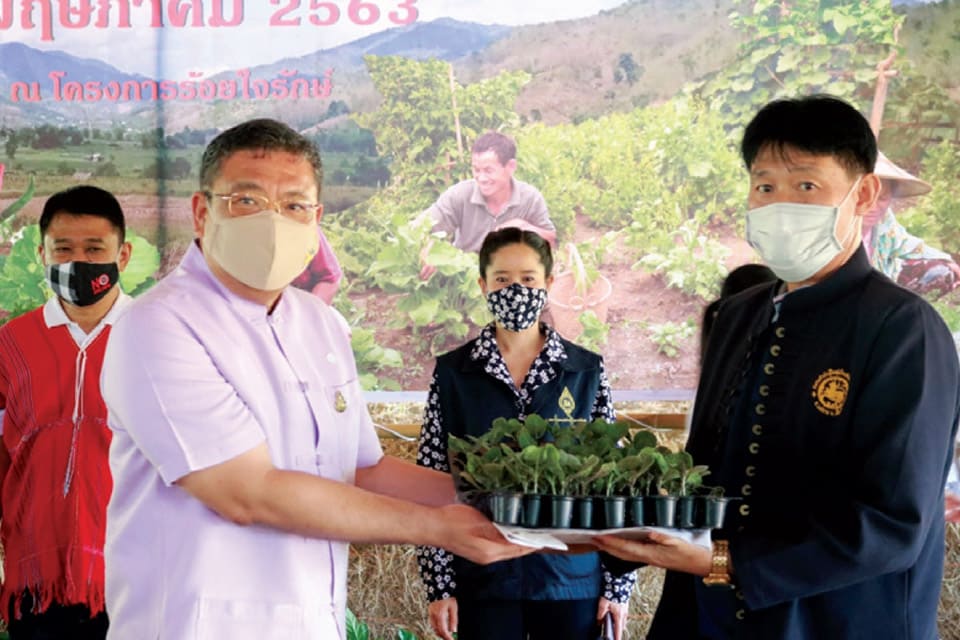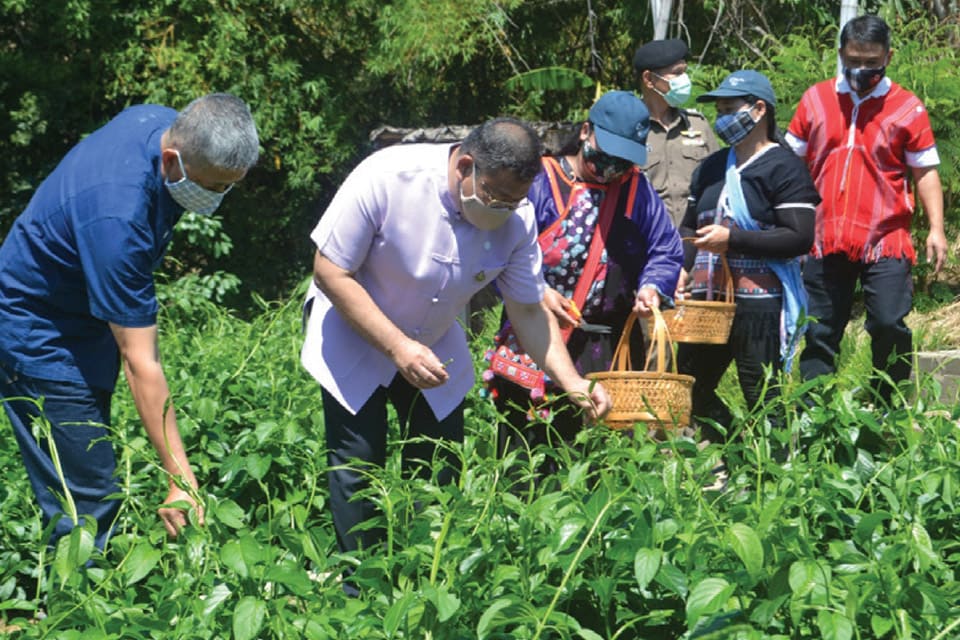Agricultural Development
2.1. Establishment of a 75-Rai Agricultural Demonstration Farm
The project has established a 75-Rai agricultural demonstration farm as a model area for integrated development activities in water resources, soil, agroforestry, and livestock in a comprehensive manner. It covers the entire process from the source (cultivation and production), to the middle (market planning), to the destination (value-added processing). This development is carried out in an area-based development approach that is suitable for different types of areas, whether they are upland areas, lowland areas, or paddy fields. Both upland areas, lowland areas, and paddy fields are equipped with modern technologies and agricultural machinery to manage the farms. This serves as a learning and working center for the community and other organizations to expand and continue. The area is divided into several zones as follows:
Upland Area – Fruit cultivation
Such as Kaew Kam Ming mango, Water Jasmine mango, Golden Good Orange, Large White Orange, Mon Thong Durian, Noi Na, Avocado, Lemon, Lemongrass, Scented Coconut, School Shade Lychee, and Water Lettuce Banana.
Sustainable Agriculture Plot
This is a demonstration area for agriculture and livestock, aiming to generate income and reduce expenses. It serves as an example of sustainable agriculture.
Experimental Plot for Pathumma and chrysanthemum
These are plants that provide beautiful landscapes and can be sold and processed into additional income.
Water System in the 75-Rai Agricultural Demonstration Farm
The water system in the agricultural demonstration farm includes plastic-lined ponds, soil-mixed cement ponds, water delivery systems for cultivation areas and paddy fields, solar-powered water pumps, and irrigation channels.
Lychee Garden
Pruning and shaping of lychee plants are conducted as an experiment to modify the canopy shape, making it easier to manage in the future. Additionally, charcoal burning experiments for lychees are carried out.
Terraced Paddy Fields and Irrigated Rice Fields
These are demonstration plots for water management aimed at increasing rice production and reducing the use of chemicals for pest and weed control through the use of bioagents.
Establishment of Nurseries and Seedling Raising Facilities
This includes the operation of nurseries to promote the interest of local residents in seedling raising activities.
Office Building
The office building serves as a workspace, temporary accommodation, and facilities for the project team. It includes meeting rooms, produce sorting facilities, dining halls, dormitories, restrooms, a pavilion, and parking lots.
In addition to being a learning center for visiting study groups, the immediate benefits for the local community from the establishment of the agricultural demonstration farm include job opportunities for local residents. Around 143 people, who had lower incomes compared to the poverty line, have been employed by the project, generating an estimated income of approximately 4,400,000 baht per year.
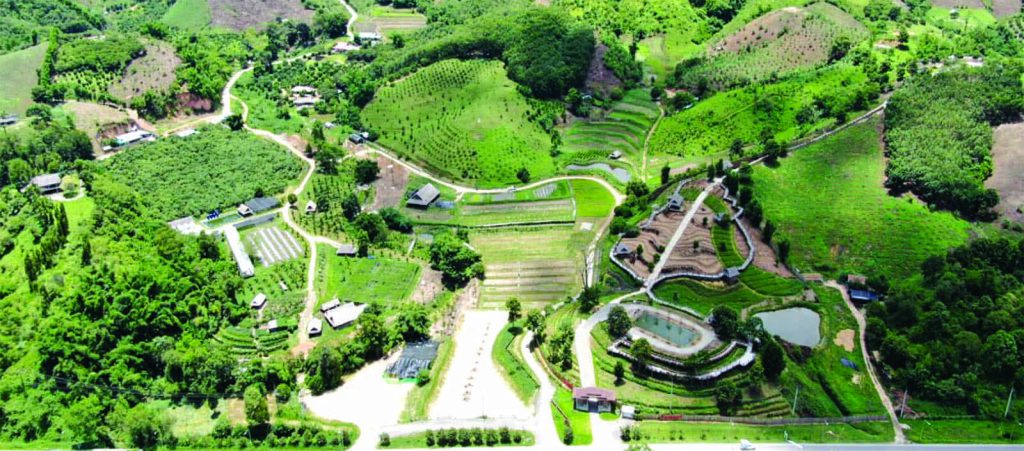
75-Rai Agricultural Demonstration Farm
2.2. Plant Yield Enhancement Research
The research team will periodically summarize the research findings every 6 months after conducting experiments in the field. This allows for monitoring progress, identifying challenges, and presenting research results on increased crop yields, soil structure improvement, and the use of bioagents instead of chemicals. The team also evaluates and provides recommendations to improve farming methods suitable for different crop types, aiming to achieve high-quality and sustainable production. These findings and recommendations will continue to be shared with the local community to promote ongoing development.
The research team will periodically summarize the research findings every 6 months after conducting experiments in the field. This allows for monitoring progress, identifying challenges, and presenting research results on increased crop yields, soil structure improvement, and the use of bioagents instead of chemicals. The team also evaluates and provides recommendations to improve farming methods suitable for different crop types, aiming to achieve high-quality and sustainable production. These findings and recommendations will continue to be shared with the local community to promote ongoing development.
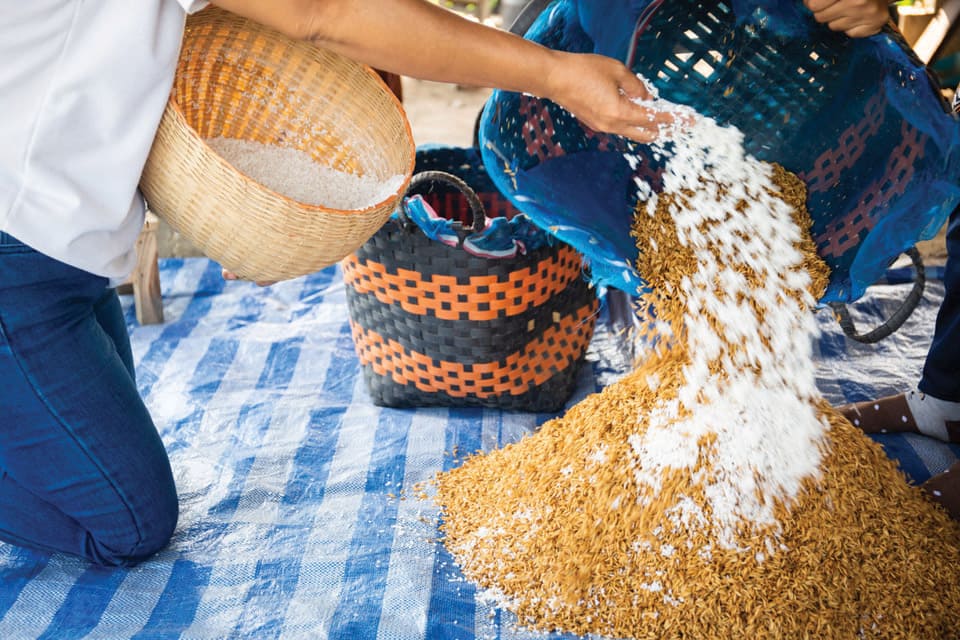
Use of biological agents instead of chemicals
2.3 Soil Maintenance and Quality Enhancement
The project, in collaboration with the Soil Development Station in Chiang Mai province, has conducted practical training on soil maintenance for a total of 93 village soil doctors.
The objective is to provide basic knowledge to the village soil doctors, including soil sampling for plant nutrient analysis, soil management, soil improvement and maintenance, soil pollution, soil and water conservation, and project-related knowledge related to soil maintenance. This knowledge will contribute to promoting appropriate crop cultivation practices in the future.
Additionally, the Soil Development Station in Chiang Mai has supported funding for plowing and harrowing to reduce burning in the fields. They have also provided sesame seeds to farmers for cultivation in the rice fields to improve soil fertility before the rice planting season. This support includes providing sesame seeds to 70 local farmers, totaling 1,950 kilograms, for an area of 390 Rai of paddy fields.
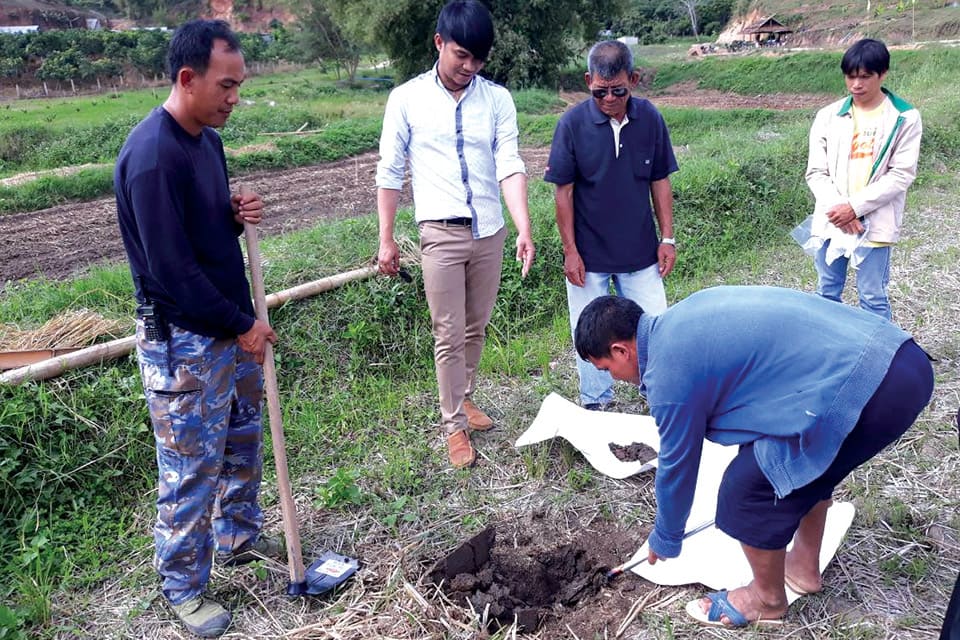
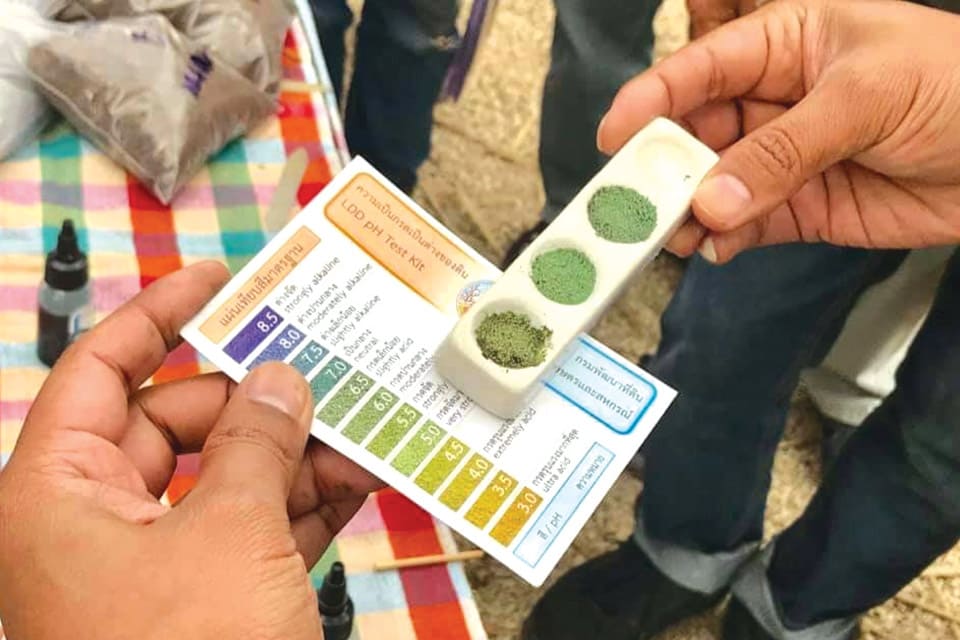
Soil maintenance workshop for volunteer soil doctors
2.4 Agricultural Study
The project has organized study visits focusing on the cultivation of important fruit crops in the project area, such as mangoes and durians, for groups of project staff, volunteer developers, and farmers. The objective is to showcase successful examples, learn good practices in tree care to achieve quality produce, understand grading methods for export, and apply the knowledge gained in the project area. A total of 6 study visits were conducted as follows:
- Study on mango cultivation and grading for export on March 15-19, 2019, at C.P. Starlen Co., Ltd. in Chonburi province.
- Study on standardizing mango plantation management for export on April 9, 2019, at a quality mango producer group for export in Phrao District, Chiang Mai province.
- Study on standardizing mango plantation management for export on August 30, 2019, at a quality mango producer group for export in Phrao District, Chiang Mai province.
- Study on durian cultivation on September 13, 2019, at Mr. Mongkol Intharaksa’s durian orchard in Mae Ai District, Chiang Mai province.
- Study on producing quality mangoes on July 15-16, 2020, at a quality mango producer group for export in Phrao District, Chiang Mai province.
- Study visit on longan cultivation on August 28-29, 2020, in Ban Inthakil, Mae Taeng District, Chiang Mai province.
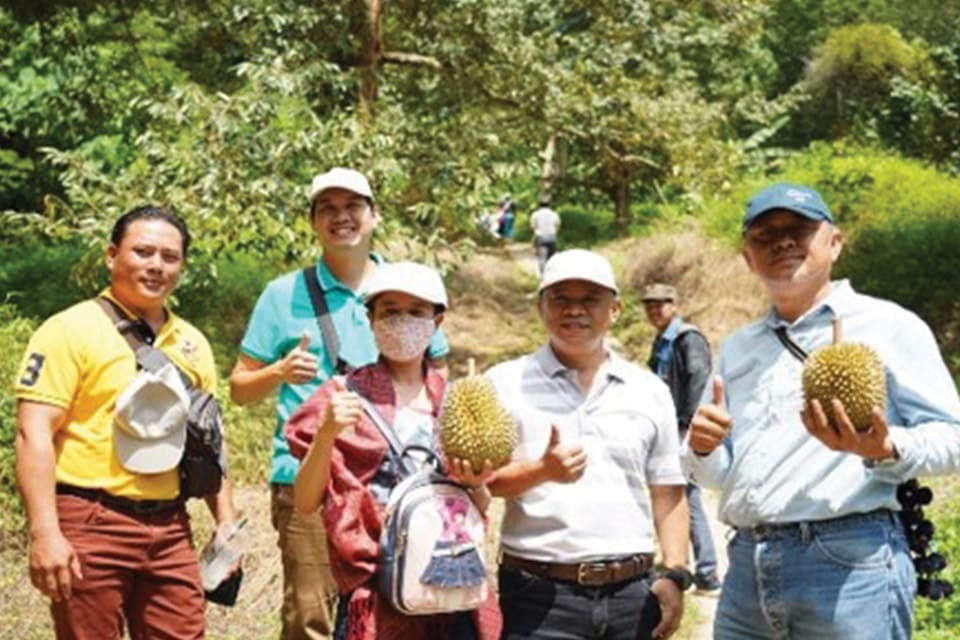
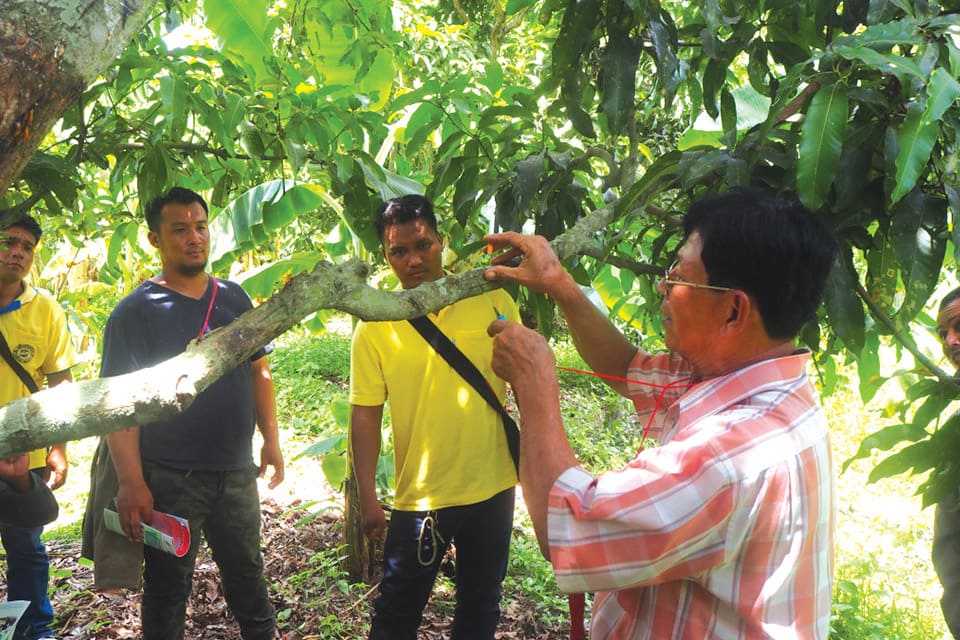
Study tour on durian cultivation and the management of mango plots to meet export standards
2.5 Short-Term Crop Promotion
The project has been promoting the cultivation of short-term crops that are already grown by local farmers in the project area, such as rice, pumpkins, and corn. The objective is to increase the quantity and quality of the produce. The project sets conditions that participating farmers must follow the designated planting calendar at every stage and provides support in the form of fertilizers and bio-products for use in the villagers’ fields, specific to each crop type, as follows:
Rice (upland and paddy)
The project aims to increase the average rice yield from 600 kilograms per rai to 800 kilograms per rai for upland rice and from 170 kilograms per rai to 320-500 kilograms per rai for paddy rice. There are 35 farmers interested in participating in yield enhancement activities for upland rice, covering a total area of 174 rai, and 27 farmers interested in participating in yield enhancement activities for paddy rice, covering a total area of 80 rai. After the harvest, it was found that the participating farmers achieved an average rice yield of 836 kilograms per rai, which exceeded the set target. However, the participating farmers’ average yield for paddy rice was 209 kilograms per rai, which did not reach the set target due to crop losses from diseases and pests.
For the rice planting season in 2563, the project conducted activities to enhance the yield of upland and paddy rice, following the same working methods and yield targets as the previous year. A total of 42 farmers participated in yield enhancement activities for upland rice, covering a total area of 217 rai (a 25% increase), and 26 farmers participated in yield enhancement activities for paddy rice, covering a total area of 100 rai (a 25% increase). The project will monitor the growth progress and provide guidance to the farmers regarding the project’s recommended practices.
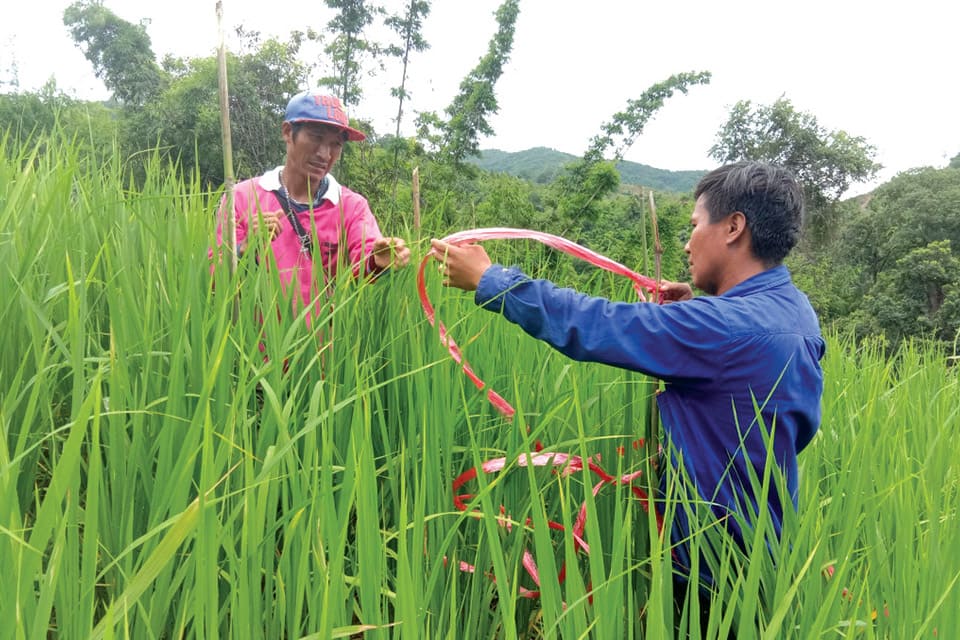
Block farm rice for estimation yield of each plot
Chrysanthemum
Since 2562, the project has been promoting the cultivation of Chrysanthemums among the villagers, starting with a group of 23 villagers from the Namrong village. They cultivated chrysanthemums in a 10-rai area and achieved good income for the villagers. When calculating the income per area, winter melon cultivation generated up to 67,015 baht per rai. Therefore, in 2563, the project expanded the promotion of winter melon cultivation, with 49 interested villagers participating and a total area of 20 rai (a 100% increase).
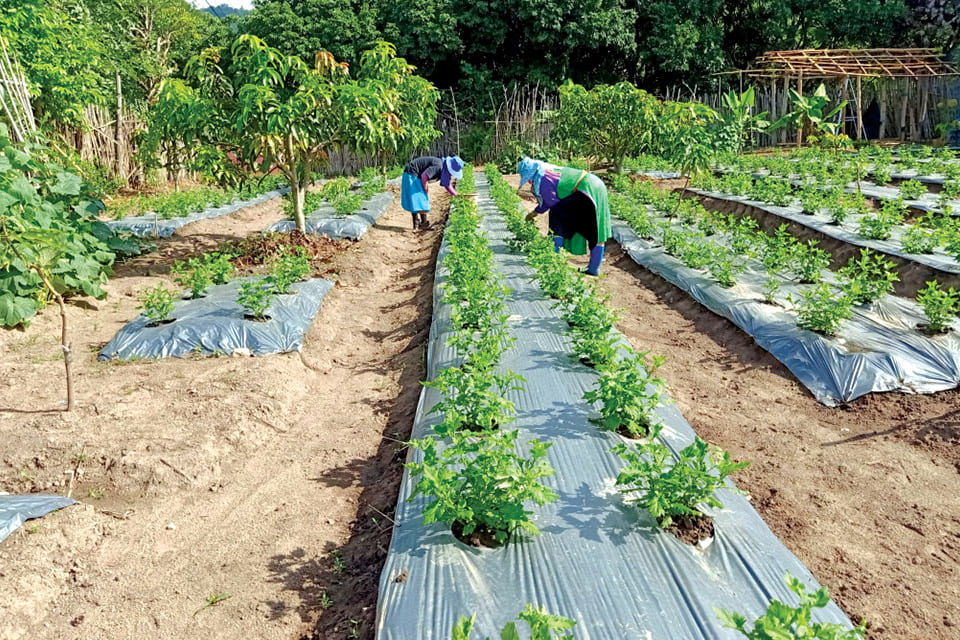
Collect the top of the chrysanthemum
Pumpkins
Since 2562, the project has promoted pumpkin cultivation among the villagers, starting with a group of 23 farmers in the Namrong village, cultivating pumpkins in a 10-rai area. It was found that pumpkin cultivation has provided a good income for the villagers, especially when considering the income per area. Pumpkin cultivation resulted in an income of 67,015 baht per rai. In 2563, the project expanded the promotion of pumpkin cultivation, with 49 interested villagers participating and a total area of 20 rai (a 100% increase).
The project provides training to farmers, advises them on planting methods and managing water systems within the fields, and continuously monitors the progress according to the planting calendar to ensure sustainable and high-quality yields. The estimated yield for dried pumpkins is set at 5 tons.
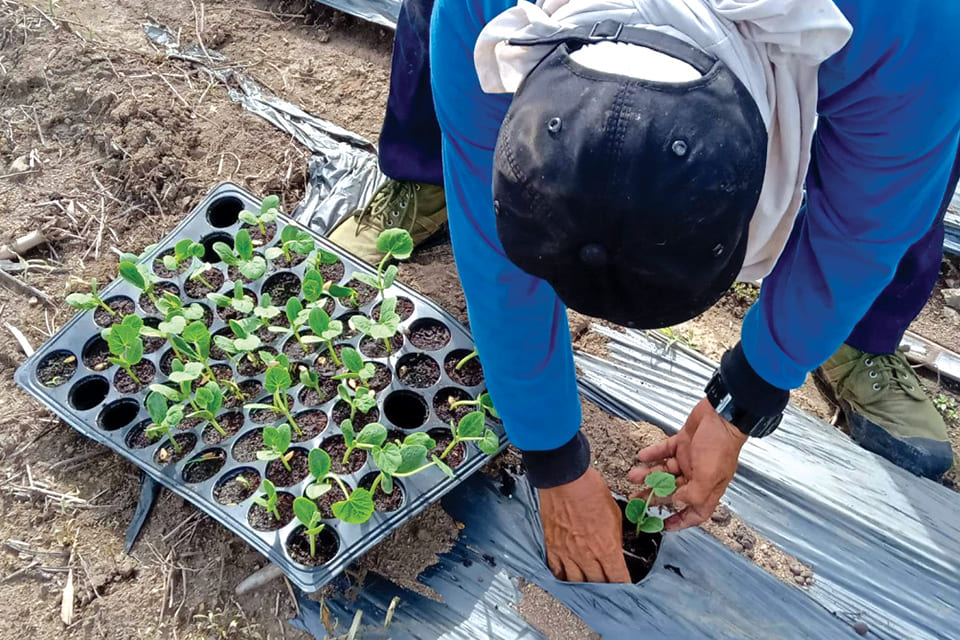
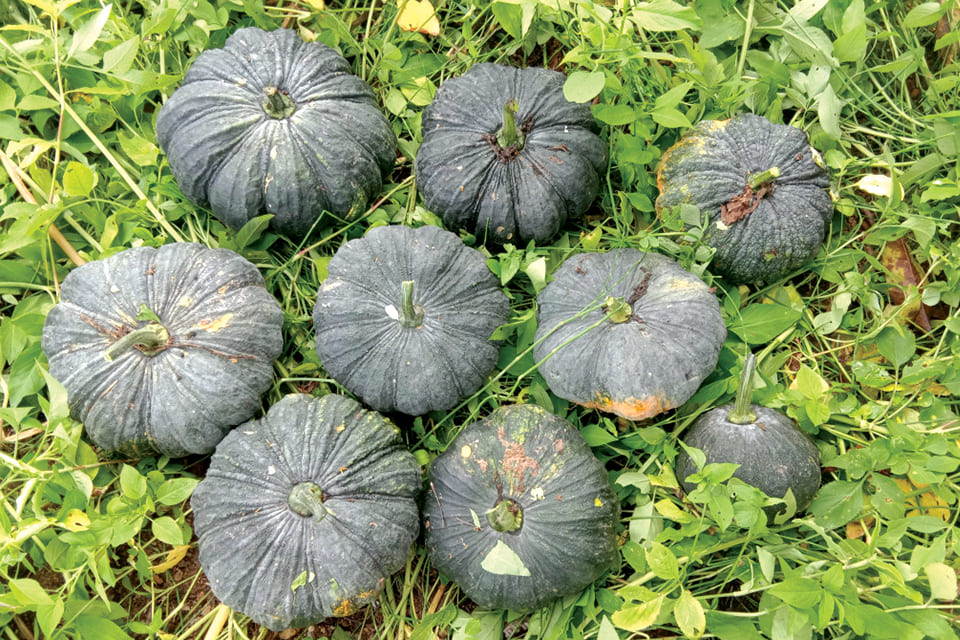
planting pumpkins and pumpkin production
Corn
The project conducted trials and research on corn cultivation during the off-season with three participating farmers, covering a total area of 8 rai. The planting method used was in rows to facilitate field management and harvest. However, during the planting period, there were challenges with insufficient water due to cultivation on hilly terrain, as well as issues with certain corn varieties, resulting in some crop losses and lower-than-expected yields.
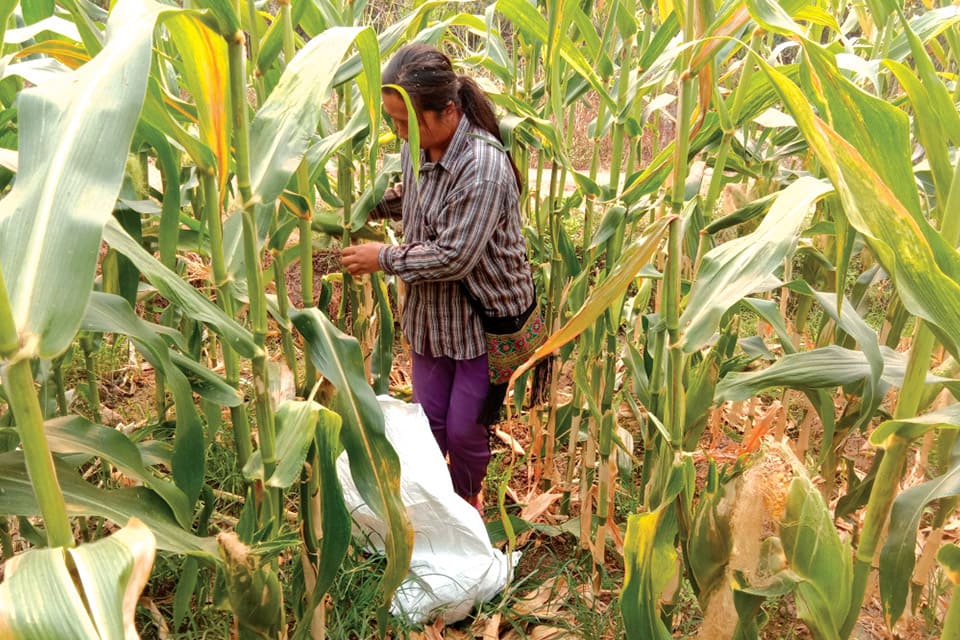
harvest sweet corn
2.6 Long-term Crop Promotion
The project has supported economically viable fruit tree seedlings such as Nak Mango, Rambutan, Coffee, Robusta, Avocado, Cashew Nut, and Kong. It has also included various forest trees such as Buoyung, Pradu, Bamboo Ruak Dam, and Bamboo Sang Mon for villagers interested in cultivating these crops in their subsistence areas to provide long-term income sources and replace monoculture crops, as well as increase forest areas within the project area. The project has supported the planting of seedlings by 1,065 villagers, covering a total area of 1,925 rai, and their growth is being monitored by project staff.
In addition to increasing the number of long-term crops in the area, the project has conducted experiments to increase the productivity and quality of popular existing long-term crops such as mango and lychee, involving 26 villagers and a total area of 42 rai. The project has monitored the growth of pruned and fertilized lychee trees according to the project’s program, as well as conducted trials of new crops such as sapodilla and cape gooseberry to assess their potential before promoting them to the villagers.
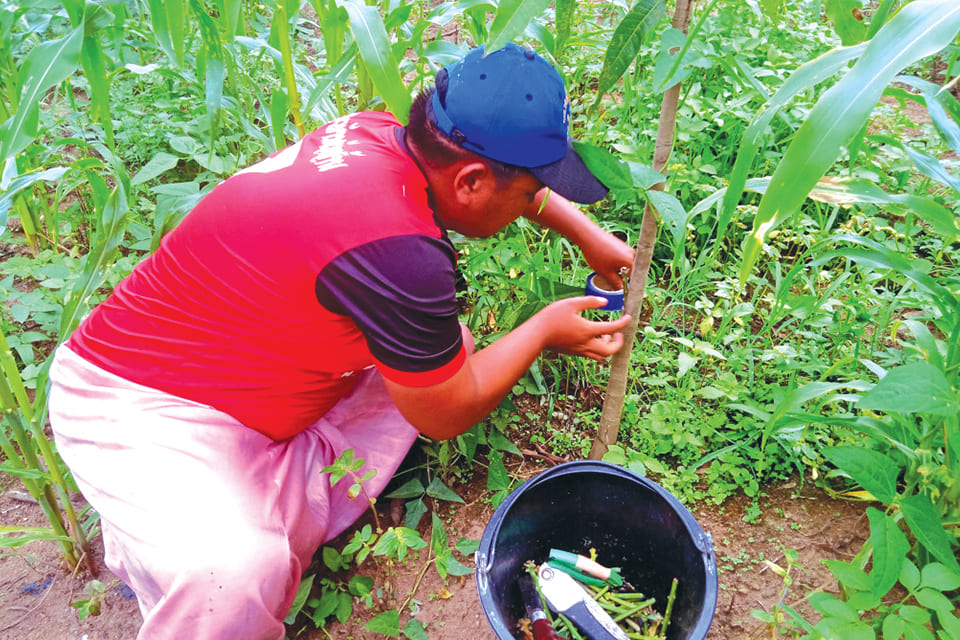
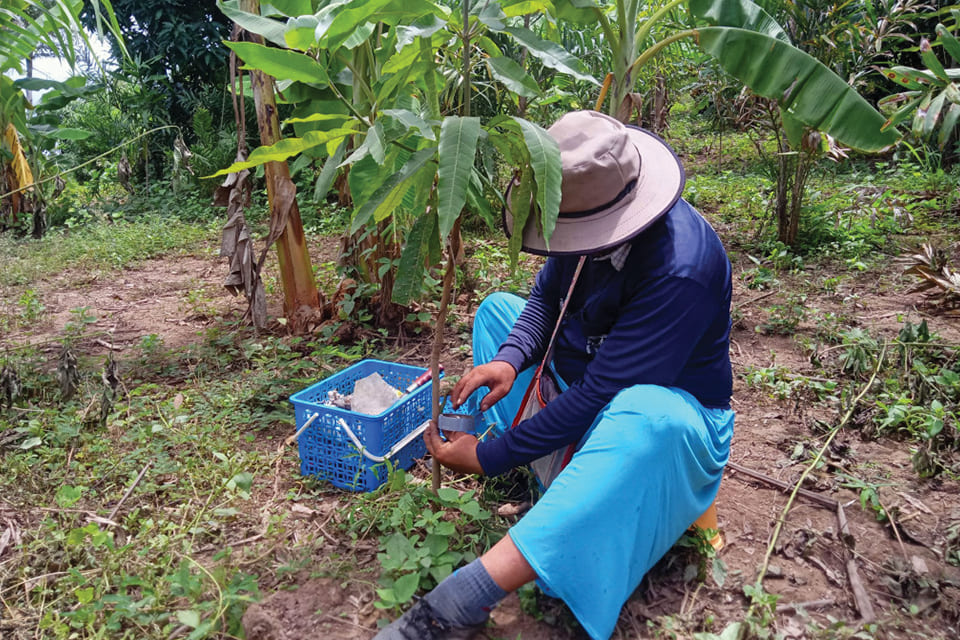
change mango varieties
The project has also collaborated with the quality fruit cooperatives in Huai San Village to provide improved mango varieties to farmers interested in enhancing mango varieties to meet market demands. From 2022 to 2023, the varieties were changed to Nam Dokmai mango and Mahachanok mango, which are in high demand and have higher prices compared to the existing Nam Khum variety in the area. The change in varieties was carried out by farmers from the quality fruit cooperative in Huai San, who have expertise in grafting. A total of 30,989 grafts were provided, and the owners of mango orchards were also trained to carry out the grafting themselves.
2.7 Supporting the Quality Fruit Cooperative in Huai San Village (In collaboration with C.P. Star Lens Co., Ltd.)
Since 2022, the project, in collaboration with C.P. Star Lens Co., Ltd., and the Quality Fruit Cooperative in Huai San Village, has been implementing measures to produce export-quality mangoes for foreign markets. Representatives from C.P. Star Lens Co., Ltd. have been responsible for inspecting the quality of mangoes in the villagers’ orchards.
They provide guidance on identifying suitable mango characteristics for harvesting and teach the farmers how to calculate the daily harvest quantity to ensure sufficient supply for transportation to purchasing factories. Throughout the cooperation, participating farmers have experienced increased income from export-quality mangoes, resulting in a 120% price increase compared to previous rates. Despite a decrease in the quantity of harvested mangoes sold, other villagers have recognized the benefits of focusing on quality mango production and have shown interest in joining the cooperative. The cooperative’s membership has grown from 6 to 23 participants.
However, due to the global impact of the COVID-19 pandemic, especially on the mango export market, prices for mangoes have decreased by approximately 40-60%, and the purchasing quantity has also reduced. Therefore, the cooperative had to manage sales through other channels, such as online platforms and local markets. Out of the 23 cooperative members, only 12 were able to meet the export standards set by C.P. Star Lens Co., Ltd. in the current year, while the others were still unable to comply with the required procedures.
In summary, the total mango production sold in 2563 amounted to 90,868 kilograms, with a total value of 1,789,805 Baht. The breakdown of sales by distribution channels is as follows:
- Export markets: 29,390 kilograms, valued at 779,340 Baht.
- Online sales: 635 kilograms, valued at 25,005 Baht.
Local markets: 60,843 kilograms, valued at 985,360 Baht.
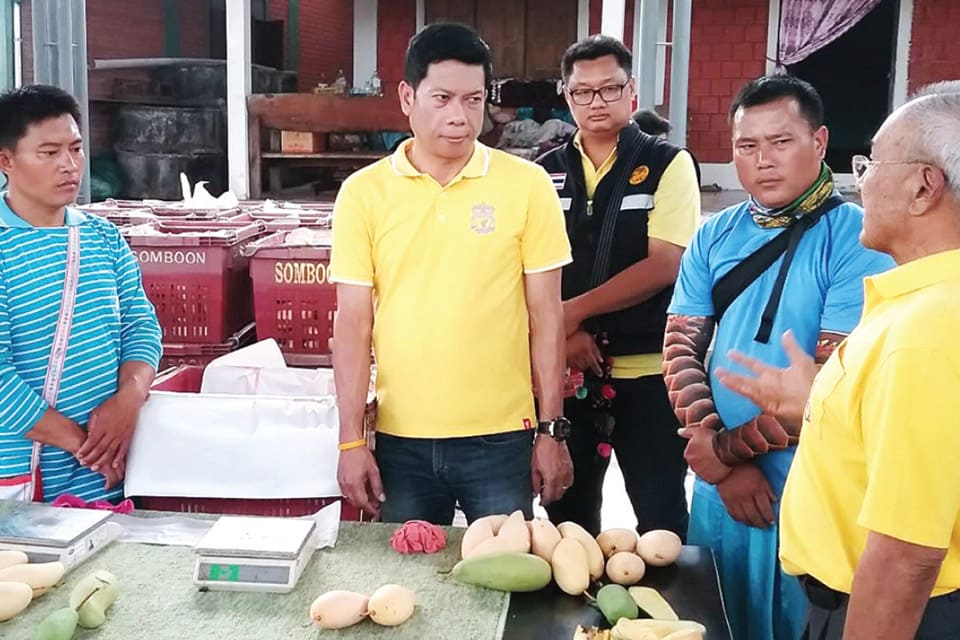
Sorting mango production according to export standards.
2.8 Promoting Household vegetable planting, Reducing Expenses
The project organized training sessions on vegetable cultivation for household consumption, targeting students from various schools such as Ban Sukha Rithai School, Chotikun Kasetbamrung School, Totsawanee Anusorn School, and Chotidkan Kasetbamrung School 3 in Huai San Village. The aim was to enhance agricultural skills among students and encourage them to utilize their free time productively by growing food for their school kitchens. This practice helps reduce household expenses in line with the principles of a self-sufficient economy, while also providing an additional income source for families. After the training, the students received vegetable seedlings to grow at home during the semester break, with teachers and parents offering guidance and monitoring their growth.
Moreover, the project promoted kitchen garden vegetable cultivation among villagers to reduce household expenses. It supported interested villagers with vegetable seedlings, providing a total of 11,086 seedlings to 556 individuals.
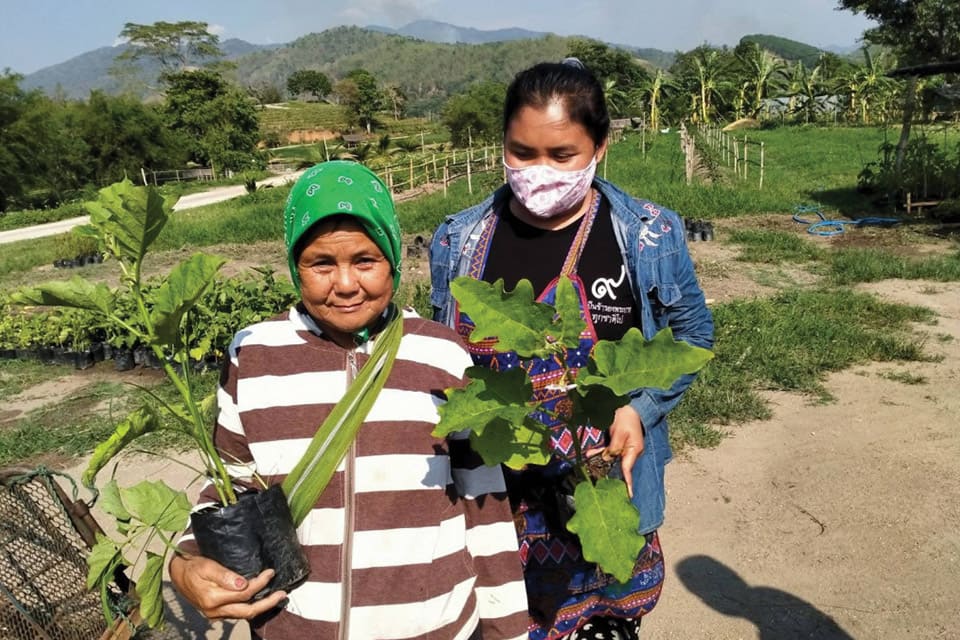
Promote vegetable seedlings
2.9 Stay-at-Home Activity: Planting Vegetables, Sharing, and Fighting COVID-19
On May 2, 2020, the project collaborated with the Community Development Office of Mae Ai District to organize the “Stay-at-Home Activity: Planting Vegetables, Sharing, and Fighting COVID-19.” The initiative aimed to promote the principles of a self-sufficient economy and alleviate the impacts of the COVID-19 pandemic by emphasizing food security and self-reliance. The event was honored by the presence of the Governor of Chiang Mai Province.
During the ceremony, the project representatives distributed vegetable seedlings and plant seeds to representatives from 7 sub-districts. A total of 35,000 vegetable seedlings and 5,000 packs of plant seeds were provided. Additionally, the villagers in the project area contributed Eco rice seeds, which were obtained from increased rice production activities in collaboration with the project, totaling 1,000 kilograms. These were given to the representatives of the 7 sub-districts to help alleviate food shortages during the COVID-19 outbreak, reflecting the strong sense of community sharing and support.
